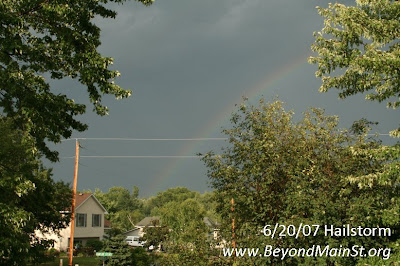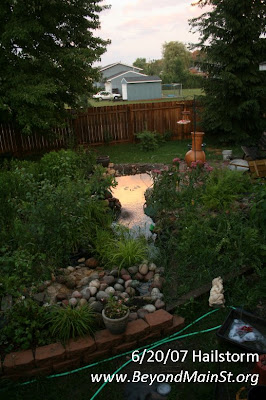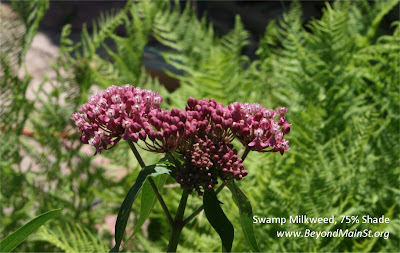Surprisingly high survival rate with this year's feeder fish. Both our old fish, and at least eleven of our twelve feeders are alive and growing.
Saturday, June 30, 2007
Friday, June 29, 2007
Marsh mallow is a native host plant especially beneficial to Painted Ladies. It's shade tolerant, likes moist soil, and has quite a spread (this one measures about 4' tall by 3' around). Its five-lobed leaves are a rich emerald green, and they're actually rather decorative. They are slow growing, though. Last year it was just a clump of low-lying leaves, and the year before it was barely distinguishable in the garden.
In bird phenology news, we spotted swarms of grackles picking across the lawns and through the wooded areas this morning.
Thursday, June 28, 2007
Wednesday, June 27, 2007
Monday, June 25, 2007
One of the hardy pond lilies I picked up at Linder's this year (non-native). The blossoms may look nice, but they're finicky little rascals. They only bloom when they have just the right amount of sun and are sitting properly on the water. Blooms only take about ten minutes to open or shut.
Though they say that these lilies are hardy, last year's specimen didn't overwinter, so I'll be moving this one to our inside pond in late October.
Sunday, June 24, 2007
First Monarch caterpillar of the year seen feeding on our Swamp Milkweed last night.
Wildlife Spotted:
- American Toad
- Baltimore Oriole
- Black-capped Chickadee
- Blue Jay
- Eastern Bluebird
- Eastern Chipmunk
- Goldfinch
- Green Frog
- Grey Catbird
- Grey Squirrel
- Grey Tree Frog
- Lightning Bug
- Monarch Butterfly
- Monarch Caterpillar
- Mourning Dove
- Northern Cardinal
- Nuthatch
- Red Admiral
- Red-headed Woodpecker
- Red-shouldered Hawk
- Red-throated Hummingbird
- Robin
- Swamp Sparrow
Natives in Bloom:
- Butterfly Weed
- Common Milkweed
- Daisy Fleabane
- Harebell
- Marsh Mallow
- Meadow Rue
- Spiderwort
- Swamp Milkweed
Saturday, June 23, 2007
Friday, June 22, 2007
I've counted three Green Frogs in our pond. We'll have to be sure to nab them before the pond ices over to avoid their dying as the oxygen level drops (they must be used to deeper lakes). The current plan is to give as many away to local nature centers as possible, and to put the rest in an aquarium. No worries; they'll all be returned to the pond once Spring rolls around.
Speaking of wildlife that have issues overwintering. Then again, maybe the DNR (and whatever Canada has) take care of these 'fresh water whales' the way we take care of our pond frogs (only on a largeer scale), removing then when/if Superior freezes over and move them into the Duluth Aquarium.
Thursday, June 21, 2007
No immediately ascertainable damage; just a blanket of hail-torn leaves on the lawn, and a few fallen branches. Our swamp ferns look like they were pretty devastated, but I think they should recover in a few weeks.
Wednesday, June 20, 2007
Tuesday, June 19, 2007
Added 40 granite cobbles to the edge of the pond over the weekend. Purchased them for around $1.49/ea from Menards. The goal here isn't to cover the entire surface of the tarp; just that which is above the water line. Granite gives it a nice, natural look, and provides less surface area for evaporation and algae growth than sand, dirt, or river rock (algae has not been a problem yet this year; not sure if that can be chalked up to the fish, the snails, the added plants, the excavating we did in the stream, or sheer luck).
The stones also provide a hiding and hibernation spot for frogs and other amphibians, most notably the Spring Peeper, who will overwinter above ground, basically freezing in place between stones or rocks or in logs, only to return to life the following spring.
Monday, June 18, 2007
Sunday, June 17, 2007
We thought we'd consider everything when we installed the new waterfall; lining it with two layers of rubber; reinforcing the concrete with poultry wire and sealing it with the same stuff they use on birthbaths. The only thing we failed to consider was the path it would take around the paver block at the output.
I didn't discover this, of course until after a little over eight hours of steady operation. By this time, the water level had dropped just enough to be perceptible. Checking around the waterfall, I found a damp spot in the soil behind the waterfall where a jet of water, fanning around the rock at the output, had run over one of the rocks at the rim, spilling a little over a gallon an hour.
I bought some special waterproofed cement from the hardware store and originally tried to patch around the edges of the paver, but that only caused the water to jet, with extra force, causing a lot of it to splash over the edge, losing water ev en more rapidly. Finally settled on removing the patch, and cementing in some more stones along the edge.
We're still losing some water, probably around a cup an hour due to splattering, but I plan to fix this by adding a dimmer to the outlet controlling the pump. Less water, less splatter, more efficiency.
Wildlife Spotted this Week:
- Baltimore Oriole
- Black-capped Chickadee
- Blue Jay
- Cedar Waxwing
- Cottontail Rabbit
- Eastern Bluebird
- Eastern Chipmunk
- Goldfinch
- Green Frog
- Grey Catbird
- Grey Squirrel
- Lightning Bug
- Monarch Butterfly
- Mourning Dove
- Northern Cardinal
- Nuthatch
- Red-bellied Woodpecker
- Robin
- Swamp Sparrow
Native Plants in Bloom this Week:
- Blue flag Iris
- Canadian Anemone
- Daisy Fleabane
- Harebell
- Spiderwort
- Swamp Buttercup
- Swamp Milkweed
Saturday, June 16, 2007
This could be because of the amount of sun each plant is getting, though it could also be because of the differences in drainage (the specimen in front is contained inside landscaping ties, while the one in the front sits on the top ofa slope), or the fact that the rear plant is contained near the pond and has a constant water source.
Friday, June 15, 2007
Thursday, June 14, 2007
Tuesday, June 12, 2007
Monday, June 11, 2007
Sunday, June 10, 2007
Amazing what you can do with a little effort and a generous amount of serendipity. By connecting a 1/4" reducer to a pump output, I was able to create a spitter jet. By anchoring the jet under a bit of cement, and putting a nicely rounded stone in front of it, we were able to create a fine spray that not only aerates the water for the fish, but also looks absolutely awesome when combined with a blue light (pumps and lights together take up about as much collective energy as a ceiling fan).
Heard a single Tree Frog in the pond towards evening. Sounds like he might be using the aluminum siding to amp up his mating call. Though it's the first Gray Tree Frog we've ever heard in the pond, if his amped-up mating call is successful, it definitely won't be the last.
Wildlife Spotted this Week:
- Baltimore Oriole
- Black-capped Chickadee
- Cottontail Rabbit
- Eastern Chipmunk
- Goldfinch
- Gray Tree Frog
- Green Frog
- Junebug
- Mourning Dove
- Nuthatch
- Robin
- Ruby-throated Hummingbird
Native Plants in Bloom this Week:
- Canadian Anemone
- Columbine
- Harebell
- Rue Anemone
- Spiderwort
- Swamp Buttercup
Friday, June 08, 2007
On Filters
We've not had the best luck with filters to date. When we first started work on the pond back in 05, we bought a $150 plastic pressurized bio/mechanical filter with a built in UV light to control the algae. About a year ago, the output nozzle snapped off, and though that was repairable with a bit of liquid weld, most of the clamps fell off this spring, the seal failed, and the UV fixture was fried by a power spike.
Just this week, we removed the old filter, and replaced it with a simpler, unpressurized one. Hopefully it removes the rust from the water just as well, as the old filter (along with a little Accuclear) was doing a bang-up job. We could have gotten the same sort of replacement, of course, but I figure that this way, we won't be putting all our eggs in one basket.
General filtering plan:
- Mechanical/mechanical filter to get out the rust&fish waste
- Plants to suck up the nitrates&cool the pond (thus preventing algae)
- Barley/Cotton pads to clarify the water and control ph
- Fish and snails to control algae
- Possibility of a UV clarifier to do the same
Monday, June 04, 2007
Birds spotted:
- Baltimore Oriole
- Black-capped Chickadee
- Blue Jay
- Crow
- Eastern Bluebird (three chicks counted)
- Grackle
- Mourning dove
- Nuthatch
- Oriole
- Red-headed Woodpecker
- Ruby-throated Hummingbird
Other Wildlife Spotted:
- American Toad
- Chipmunk
- Green Frog
- Grey Squirrel
- Raccoon
Natives in bloom:
- Canadian Anemone
- Columbine
- False Indigo
- Harebell
- Prairie Ninebark
- Rue Anemone
- Swamp Buttercup
Non-natives in Bloom:
- Fuschia
- Tuberous Begonia
Things I should have considered when I originally built the pond:
- How to do it all with one piece of tarp
- Where all pumps, accessories, power cords, and hoses would go, and how they would be rigged and concealed.
- How I planned to hide the pond tarp (on the rebuild, I excavated a submerged shelf for boulders).
- How to better integrate it with the patio/deck/surrounding landscape
- The specific needs of wildlife that might be interested in it (frogs that require oxygen-rich water for hibernation)
- Learned more about fish. Turns out that, given the correct circumstances, you can add a number of fish to your pond, including minnows, guppies, and swordtails.









































